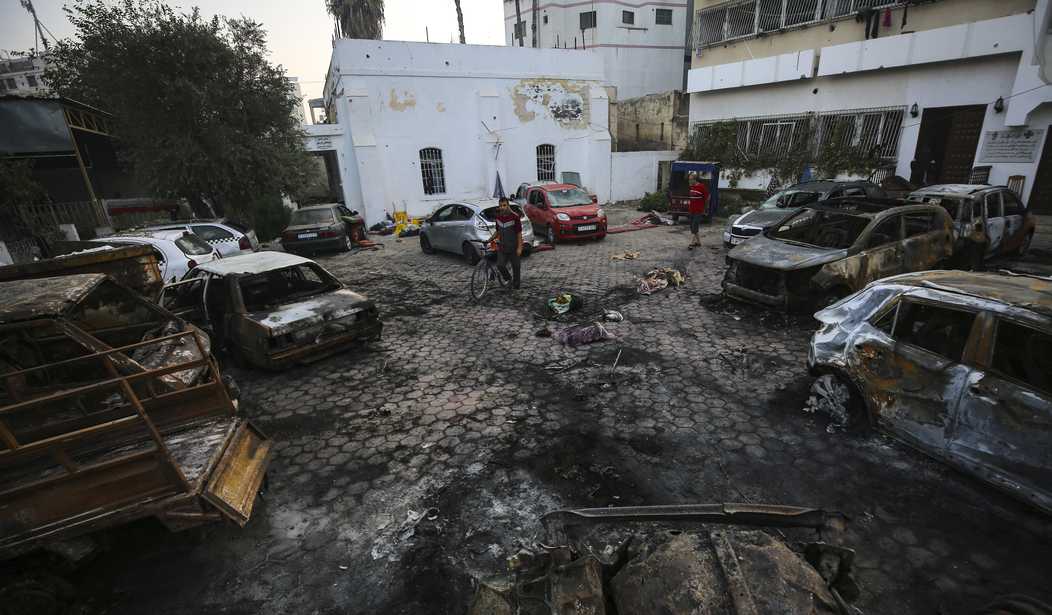Ah, conspiracy theories. From the insane (“Reptile People secretly run everything!”), to the plausible (“Lee Harvey Oswald didn’t kill JFK, at least on his own”), to the malicious (Holocaust denial), everybody knows about them, believes them, or acknowledges them ironically. This past week saw a new one in the form of the malfunctioning Hamas missile burning a hospital being turned into an airstrike by Israel.
Rick explained why the Arab governments push this conspiracy theory in his own column, as advancing antisemitism among their population benefits their own agendas. Victoria recently covered how Hamas has previously faked incidents of war crimes and blamed Israel for them.
But this isn’t about willfully believing or pushing conspiracy theories out of malice.
How did this initial conspiracy theory get reported as fact by outlets like the New York Times, the Washington Post, and CNN, giving them the benefit of the doubt (which is a conspiracy theory in itself)?
As this incident has demonstrated, conspiracy theories exist to fill any ambiguities in events as we learn of them. To keep going with this example, we first hear of a hospital in Gaza blowing up. Anybody would be at least surprised this happened and want to know why. Hamas takes advantage of this confusion and says Israel did it. Some people will naturally express skepticism when Israel vehemently denies their wrongdoing and says they will provide proof exonerating them (“If they know they are innocent, why are they so angry at the accusation?”).
More to the point, conspiracy theories take advantage of half-truths and the human ability to detect patterns, even if they do not meaningfully exist. We know Hamas intentionally hides in or near places such as hospitals, schools, mosques, and other population centers. At the same time, Israel’s initial proof of rocket footage was out of date, and the supposedly intercepted phone call between two Hamas operatives may not sound convincing to some.
As a result, people may start to think there is more to an event than there really is, as though something is being covered up.
When you add in eyewitness testimony and all of its problems related to perception like not remembering details or noticing different ones, especially when seeing traumatic events, it is easy to think something else was going on.
Just look at some of the other famous conspiracy theories: Rumors about John F. Kennedy’s mob ties have led people to believe the Chicago Outfit arranged Kennedy’s murder, Oswald was the fall guy, and Jack Ruby was to silence him. Alternatively, the CIA killed Kennedy for several reasons, namely he intended to dissolve them or replace leadership.
In the instance of 9/11 conspiracy theories, it is easy to think American Airlines Flight 77 does not look like an airplane owing to how quickly it was flying in the archived footage, leading people to believe it was a missile.
Even Holocaust deniers are capable of twisting inconsistencies in eyewitness testimony or wartime rumors and hearsay of the gas chambers, shootings, and other atrocities as somehow proving they were fake.
As such, this is also why conspiracy theories are capable of retaining believers even in the face of debunking: official reports and investigations are incapable of addressing every single detail, and the fact that questions can still remain means the compilers of the official record know more they are not sharing.
In other words, you cannot prove a conspiracy theory wrong because it doesn’t let itself be proven wrong.
When you combine this lack of falsifiability with the raging antisemitism of Israel’s neighbors, it is easy to see how even though the evidence shows Israel didn’t blow up that hospital, people want to believe it.










